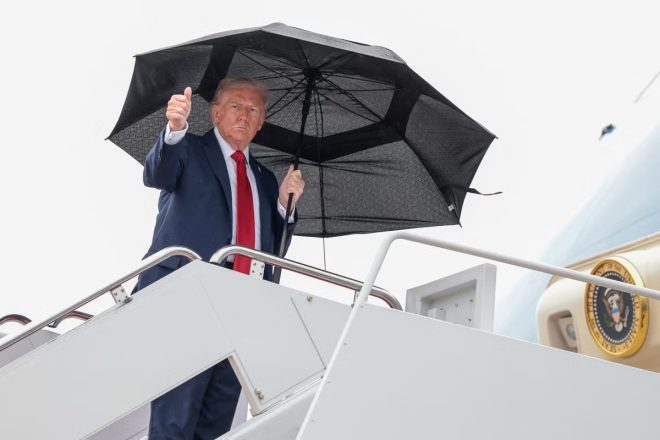
U.S. President Donald Trump has declared that the long and deadly war in Gaza is finally over. His statement came while he was on Air Force One, flying to Israel to witness the first stage of a peace and hostage-release deal between Israel and Hamas.
Speaking to reporters, Trump said confidently, “The war is over. You understand that?” He called the moment “very special” and said his visit would mark “a new chapter of peace” for the Middle East. The trip includes stops in Israel and Egypt, where leaders will meet to celebrate the ceasefire and discuss the next steps toward rebuilding Gaza.
The Peace Deal and Hostage Release
Under the new agreement, a three-day ceasefire has started in Gaza. During this pause in fighting, Hamas is expected to release 20 Israeli hostages who are still alive, along with the remains of 28 others who were killed during the conflict.
In exchange, Israel will release about 250 Palestinian prisoners and allow more than 1,700 Gaza detainees and 22 minors to go free. However, top Hamas leaders and fighters will not be part of the deal.
The peace deal was negotiated by the United States, Egypt, Qatar, and Turkey countries which have played key roles in trying to end the violence. Trump plans to meet with Israeli Prime Minister Benjamin Netanyahu and other regional leaders, including Egyptian President Abdel Fattah el-Sisi and Palestinian Authority President Mahmoud Abbas. The leaders are also expected to attend a regional peace summit in Sharm El-Sheikh, Egypt.
Israel Responds with Caution
While Trump’s declaration grabbed headlines, Israeli officials have responded more carefully. Prime Minister Netanyahu has not publicly called the war over, emphasizing that Israel’s military must remain on alert to prevent Hamas from regrouping or rearming.
“The ceasefire is an important step,” Netanyahu said in a brief statement, “but Israel’s security will always come first.”
The Israel Defense Forces (IDF) confirmed they are preparing to receive the returning hostages but noted that operations against remaining Hamas strongholds would continue if necessary.
Hamas, meanwhile, welcomed the ceasefire and confirmed its commitment to the prisoner exchange. Some of its senior officials even mirrored Trump’s language, saying the “war is finished.” Still, analysts warn that both sides remain wary and peace remains far from guaranteed.
Devastation in Gaza
The war, which erupted nearly two years ago, has left a trail of destruction across Gaza. More than 67,000 Palestinians have been killed, and much of the territory’s infrastructure has been leveled.
Hospitals, schools, and residential buildings have been destroyed, and over 1.5 million people have been displaced. Aid groups warn that famine and disease remain serious threats.
With the ceasefire in place, humanitarian corridors have reopened, allowing convoys of food, medicine, and fuel to enter Gaza for the first time in months. International aid organizations are now racing to deliver relief to desperate families.
Rebuilding, however, will be an enormous task. Entire neighborhoods have been flattened, power and water systems are in ruins, and sanitation networks have collapsed. Questions also linger over who will govern Gaza once the ceasefire holds Hamas, the Palestinian Authority, or an international transitional body.
Political Tensions and Unanswered Questions
Trump’s declaration has been met with both celebration and skepticism. Supporters say his push for a ceasefire has achieved what previous administrations could not a tangible step toward ending the cycle of bloodshed. Critics, however, argue that his statement may be premature, warning that the ceasefire could unravel if either side violates its terms.
Israel has previously seen truces collapse within days, and several military analysts caution that peace in the region remains fragile. “This is a moment of calm, not necessarily an end,” said one Israeli defense official.
The prisoner exchange has also stirred controversy. Some Israelis oppose releasing detainees accused of violent acts, while others believe it is a necessary compromise to bring hostages home.
Iran, a longtime backer of Hamas, has declined to join the peace summit in Egypt, citing continued U.S. sanctions and what it called “American aggression” in the region. Tehran’s absence raises doubts about whether a long-term peace framework can hold without its participation.
A Defining Moment
As Air Force One touches down in Tel Aviv, Trump is expected to attend a ceremony marking the first phase of hostage returns. From there, he will head to Egypt for talks aimed at shaping Gaza’s reconstruction and ensuring that the truce remains intact.
For the families of Israeli hostages, Monday may bring long-awaited reunions. For the people of Gaza, it offers the first glimpse of relief after years of war.
Still, few believe the region’s decades-long conflict can be declared over so easily. Behind Trump’s optimistic tone lies a complex web of mistrust, trauma, and political divides that will take years to mend.
“Peace is possible,” Trump told reporters. “And today, we proved it.”
GIPHY App Key not set. Please check settings